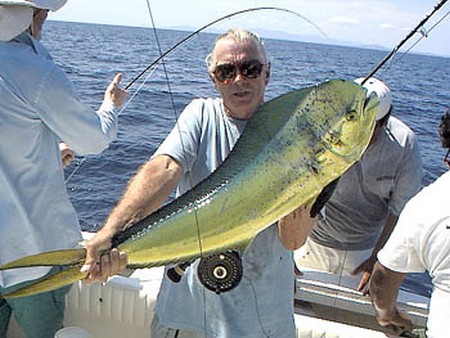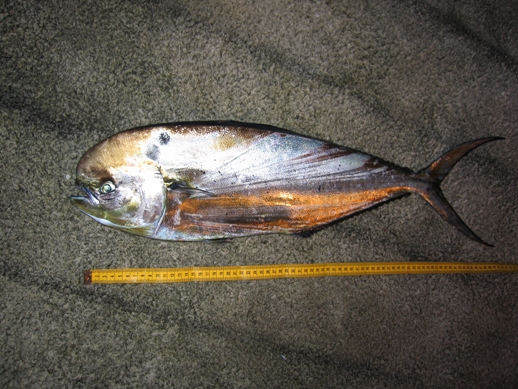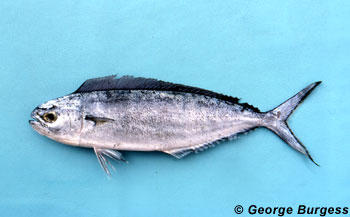
Coryphaena equiselis
FAMILY
Coryphaenidae
TAXONOMY
Coryphaena equiselis Linnaeus, 1758, type locality not specified.
OTHER COMMON NAMES
English: Pompano dolphin; Japanese: Ebisu-shiira.
PHYSICAL CHARACTERISTICS
Body is fusiform and elongate, with a vertical head profile
and a bony crest in adults, especially males; it is much less
pronounced than in the common dolphinfish. The single
dorsal fin has 52–59 soft rays and extends from just behind
the gills down to the caudal peduncle. The anal fin is long,
with 24–28 soft rays, and extends from the anus to the caudal
peduncle. The caudal fin is forked. Body color is metallic
blue and green on the back and silver with gold spots and a
golden sheen on the flank, with a dark dorsal fin. Upon
death, the dorsal color fades to gray. The caudal fin margin
of juveniles is white. Grows to 50 in (127 cm) in length but
lives only 4 years.
DISTRIBUTION
Tropical and some subtropical seas worldwide.
HABITAT
Pelagic but ventures inshore to forage off reefs or emergent
rocks.
BEHAVIOR
A schooling species that swims in pelagic surface waters but
also ventures inshore. Follows boats or hovers under floating
structures, such as tree trunks or palm leaves. Attracted to fish
aggregation devices.
FEEDING ECOLOGY AND DIET
Preys on smaller fishes and squids in addition to miscellaneous
pelagic prey, which it hunts in schools or groups.
REPRODUCTIVE BIOLOGY
Reproduction is not well known, but apparently it courts and
spawns in groups or aggregations and produces pelagic eggs
and larvae.
CONSERVATION STATUS
Not listed by the IUCN, but may be vulnerable to overfishing.
Recognized under Annex I of the 1982 Convention on the Law
of the Sea because of its migratory habits.
SIGNIFICANCE TO HUMANS
A minor commercial species sought after by consumers for its
excellent food quality. It is highly prized in sport fisheries, especially
off South America. Also taken in subsistence fisheries.
Other popular Animals
Photo Gallery of - Pompano dolphinfish





 Animalia Life
Animalia Life